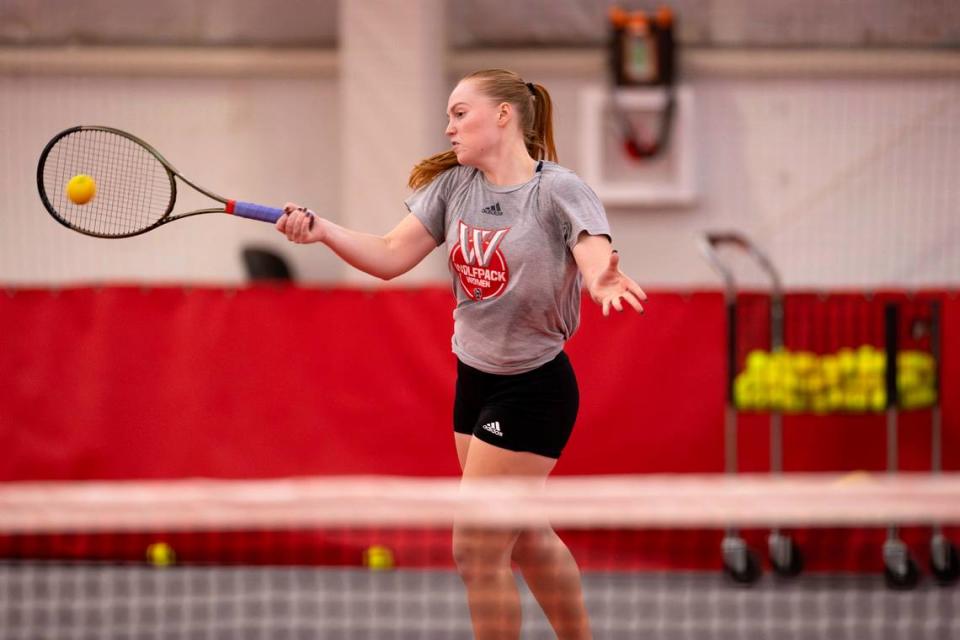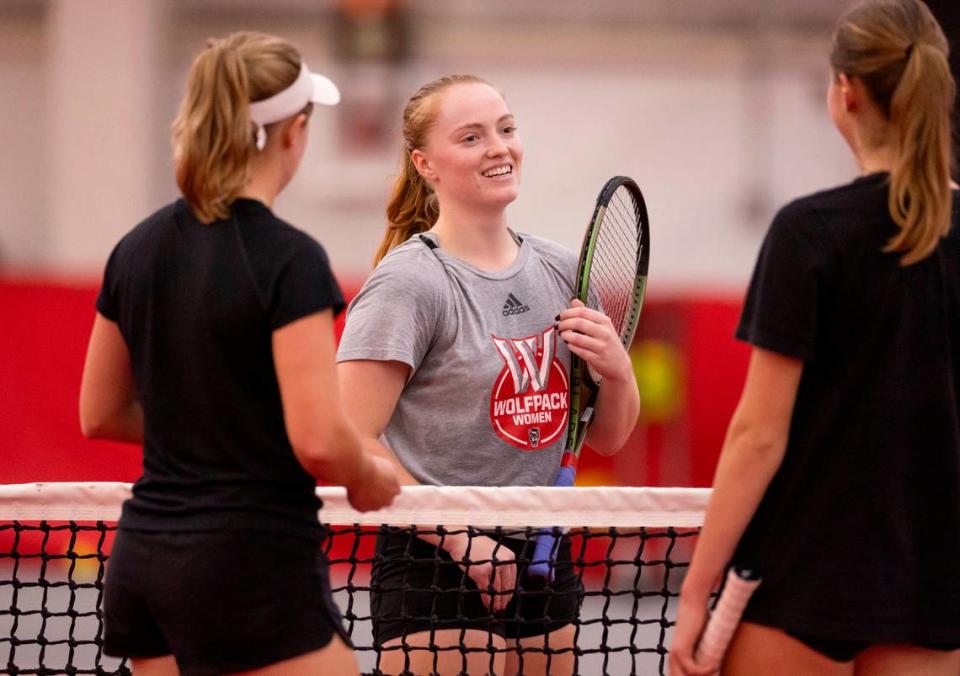Tennis with a twist: NC State women are title contenders. How gymnastics played a part
Clad in a pink and black leotard, Sophie Abrams released from the high bar into a twisting layout dismount.
She stuck the landing.
Minutes later, during a balance beam routine, Abrams nailed a back handspring into a back layout.
Nearly a decade ago, at 11 years old, Abrams was a Level 9 gymnast, tossing and twirling through the air and landing on a track that takes some youngsters all the way to the Olympics.
These days, Abrams’ focus is less on where she’s going to land an aerial stunt, and more on where she’s going to place the next shot — off her tennis racket.
A senior on the N.C. State women’s tennis team, Abrams has an unusual resume for a collegiate tennis player, starting her tennis and gymnastics careers simultaneously at age 4., and competing at both until she was 12.
Gymnastics were Abrams’ top choice for the first six years of her career, but in middle school, she said, she “hit a stride” with tennis. She’d begun working with a tennis coach at age 8, and over time connected with her coach and began to see significant progress.
“Even though I love the sport, and I loved my team, I just knew long term that’s not something I was going to be able to do,” Abrams said of gymnastics. “Around that time I started to get a little bit more momentum to tennis. … I think I saw the long-term enjoyment that I would have from tennis compared to gymnastics.”
Some years later, that choice has paid off — for Abrams and for the Wolfpack.
Abrams is 56-32 as a singles player at N.C. State, and 47-20 in doubles. She clinched the program’s first ACC title last season after defeating North Carolina’s Elizabeth Scotty in straight sets (7-5, 6-1).
UNC went on to beat N.C. State in the 2023 NCAA Championship match, 4-1, though, and Abrams is back for one more shot at the crown.

Abrams makes a choice
Coaches, doctors and athletes tout the significance of playing multiple sports, especially for children who want to compete on an elite level. It’s common to see overlap with soccer, track and field, softball or baseball, basketball, football and wrestling.
Abrams took an unusual route with her gymnastics experience, competing for eight years before specializing in tennis.
She devoted her life to athletics, practicing tennis and gymnastics four days a week. Abrams spent six to seven hours in the gym on the days she didn’t double up with tennis practice. She home schooled in order to meet training goals.
“I enjoyed doing something where I got to flip around the whole time,” Abrams said.
Abrams set her sights on college, uncertain whether competing for a national team spot would be feasible. Unfortunately for Abrams, mental blocks — similar to what Simone Biles experienced at the Olympics — made competing unsafe. She questioned whether she could compete at the same level for six years, and worried about the high risk of burnout.
“My coaches were like, ‘Look, if you’re not here, six days a week, it doesn’t make sense for you to compete these big skills, because you’re gonna get hurt if you’re not doing it consistently,’” Abrams recalled. “I was kind of confined in that sense of like, ‘OK, I need to make a choice at this point.’”
She chose tennis, but all the years of gymnastics paid off anyway.
The senior loves the performance aspect of both sports and feeding off fan energy, which is where she thinks there’s the most overlap.
N.C. State women’s tennis coach Simon Earnshaw said gymnastics provided Abrams plenty of physical benefits, too. Notably, it helped her develop forearm and grip strength that many women don’t have, giving her the ability to maintain a still racket on contact. Abrams also has a strong sense of body movement, location and force, known as proprioception or kinesthesia.
Earnshaw noted the success athletes from Eastern European countries experience in both sports. The world’s No. 1-ranked women’s tennis player, Iga Swiatek, is from Poland, for example.
“[Gymnasts] have very good control of their bodies,” Earnshaw said. “Tennis is a sport that involves a moving ball, for you to be moving, and everything working independently in sync with one another. … Sophie’s really strong; extremely strong core. She can translate power from the ground up through her body well. It’s a perfect segue into what you need to do well in tennis.”

‘Made of sterner stuff’
Abrams entered college as the No. 3 recruit from the state of Tennessee when she committed to Memphis of the American Athletic Conference.
As a Tiger, she earned the league’s Freshman of the Year and unanimous All-Conference honors.
But Abrams wanted more. She entered the transfer portal after one season at Memphis. Earnshaw emailed her within 24 hours.
“My first conversation with Simon was super long, as is anyone’s first conversation with him. I think it was two and a half hours,” Abrams said. “But, I thought, ‘This guy is different. I think different is good.’”
The program didn’t recruit Abrams as a high school student. Earnshaw said that was a combination of Covid restrictions and how she was “extremely under the radar.”
The pandemic, however, helped Abrams get to Raleigh. N.C. State’s staff saw film of her matches and the way she competed closely with top players. At the time, it made sense to seek a proven transfer over recruiting high school athletes.
Abrams struggled in the 2021-22 season, with new academic expectations, a heightened level of competition, and being far from home all weighing her down.
A memory that sticks out to Earnshaw from that season was Abrams missing a shot that would have given N.C. State a win over Duke. He jokes about it being a moment he “can’t unsee,” but he also praised her resilience and mental fortitude to pick up individual wins over North Carolina two days later.
“I’d say 99 out of 100 people would never recover from that,” Earnshaw said. “It’s like missing a penalty to win the World Cup or dropping an absolute duck in the end zone to win the Super Bowl and win player of the game, but she’s built from sterner stuff, mentally and physically.”
Team-first attitude
Her positive strides helped the team earn a spot in the Elite Eight that year.
“If we were fortunate enough to have a fourth year with her, she’d probably be one of the winningest players of all time in the program,” Earnshow added.
Abrams hasn’t regretted her decision to transfer, or to quit competitive gymnastics, despite some of the challenges and feelings that came with the decisions, because those times were worth it, she said. She grew as an athlete, student and person.
(Admittedly, her growth hasn’t extended to her height. She’s only 5-foot-3 and would fit on the Wolfpack’s gymnastics roster just fine.)
Abrams is also setting the standard for the tennis program’s future, not just her own. Everything she does is for the Wolfpack, and the people who will follow.
The Pack is No. 7 in the most recent national tennis rankings, while UNC is No. 1. N.C. State hopes to once again take down the Tar Heels this year — with Abrams’ help.
“She’s one of these people that doesn’t necessarily demand the spotlight or come in and actively politic to play high,” Earnshaw said. “She puts the team goals ahead of hers. On teams that do well, these people are paramount. Without her consistent presence and being very reliable, none of this can happen.”
Maybe she’ll do her aerial or back tuck again — if the tennis team wins its last match of the season.


